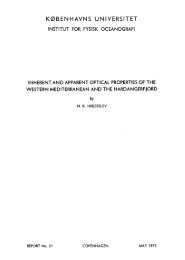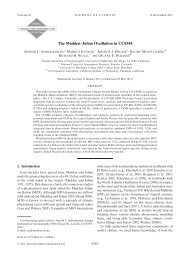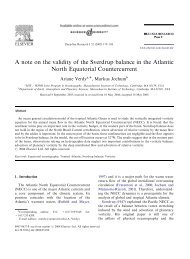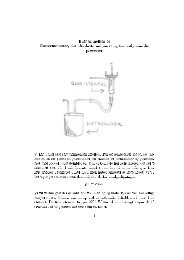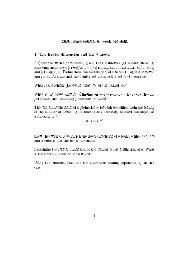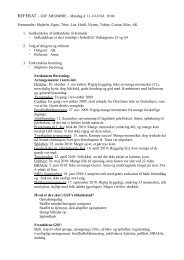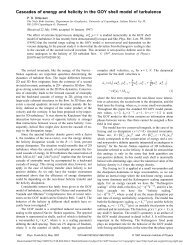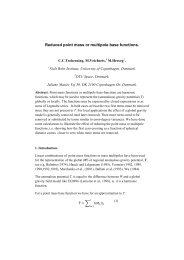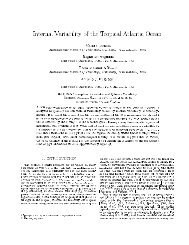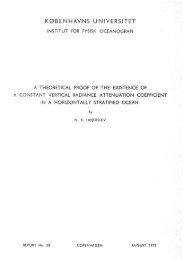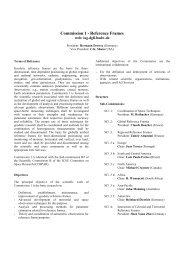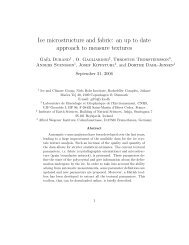Calibration of satellite gradiometer data aided by ground gravity data
Calibration of satellite gradiometer data aided by ground gravity data
Calibration of satellite gradiometer data aided by ground gravity data
You also want an ePaper? Increase the reach of your titles
YUMPU automatically turns print PDFs into web optimized ePapers that Google loves.
Journal <strong>of</strong> Geodesy (1998) 72: 617±625<strong>Calibration</strong> <strong>of</strong> <strong>satellite</strong> <strong>gradiometer</strong> <strong>data</strong> <strong>aided</strong> <strong>by</strong> <strong>ground</strong> <strong>gravity</strong> <strong>data</strong>D. Arabelos 1 , C. C. Tscherning 21 Department <strong>of</strong> Geodesy and Surveying, University <strong>of</strong> Thessaloniki, GR-540 06 Thessaloniki, Greece e-mail: arab@eng.auth.gr;Tel: +30 31 996091; Fax: +30 31 9964082 Department <strong>of</strong> Geophysics, University <strong>of</strong> Copenhagen, Juliane Maries Vej 30, DK-2100 Copenhagen, DenmarkReceived: 10 October 1996 / Accepted 25 May 1998Abstract. Parametric least squares collocation was usedin order to study the detection <strong>of</strong> systematic errors <strong>of</strong><strong>satellite</strong> <strong>gradiometer</strong> <strong>data</strong>. For this purpose, simulated<strong>data</strong> sets with a priori known systematic errors wereproduced using <strong>ground</strong> <strong>gravity</strong> <strong>data</strong> in the very smooth<strong>gravity</strong> ®eld <strong>of</strong> the Canadian plains. Experiments carriedout at di€erent <strong>satellite</strong> altitudes showed that therecovery <strong>of</strong> bias parameters from the <strong>gradiometer</strong>``measurements'' is possible with high accuracy, especiallyin the case <strong>of</strong> crossing tracks. The mean value <strong>of</strong>the di€erences (original minus estimated bias parameters)was relatively large compared to the standarddeviation <strong>of</strong> the corresponding second-order derivativecomponent at the corresponding height. This meanvalue almost vanished when <strong>gravity</strong> <strong>data</strong> at <strong>ground</strong> levelwere combined with the second-order derivative <strong>data</strong> setat <strong>satellite</strong> altitude. In the case <strong>of</strong> simultaneous estimation<strong>of</strong> bias and tilt parameters from o 2 T =oz 2 ``measurements'',the recovery <strong>of</strong> both parameters agreed verywell with the collocation error estimation.Key words. Satellite <strong>gradiometer</strong> <strong>data</strong> á Parametriccollocation1 IntroductionA spaceborne <strong>gravity</strong> mission will be executed usingSatellite to Satellite Tracking (SST) and/or SatelliteGravity Gradiometry (SGG). In both cases the quality<strong>of</strong> the result must be assessed in an independent manner.As a supplement to on-board calibration and monitoring,the occurrence <strong>of</strong> systematic errors must bemodelled, detected and eliminated if present.Correspondence to: D. ArabelosAlready, the way the measurements are collectedmay aid in this task, i.e. we may use the fact that the<strong>ground</strong> tracks <strong>of</strong> the orbits cross each other, here<strong>by</strong>making it possible to take advantage <strong>of</strong> the strongspatial correlation <strong>of</strong> the <strong>satellite</strong> <strong>data</strong>. We have studiedhow this may aid in detecting systematic errors (biasesand tilts).A similar strong correlation is obviously present betweenspace <strong>data</strong> and <strong>ground</strong> <strong>data</strong> ± otherwise we couldnot aim at using space <strong>data</strong> for determining geoid and<strong>gravity</strong> at <strong>ground</strong> level. We may take advantage <strong>of</strong> thisand use <strong>data</strong> in areas with very well determined <strong>gravity</strong>anomalies. Using simulated <strong>data</strong> from an area with verysmooth <strong>gravity</strong> anomalies, we have shown how systematicerrors may be determined and eliminated. Theadvantage <strong>of</strong> using an area with smooth <strong>gravity</strong> is thatwe obtain a very good signal-to-noise ratio, which helpsexperiments with random and systematic errors.The smooth area studied is located on the Canadianplains (56 / 68 ; 126 k 106 ). Insidethis area is an even smoother area (59:5 / 64:5 ; 117:5 k 112:5 ) with <strong>gravity</strong> standarddeviation (SD) (after subtraction <strong>of</strong> a high order reference®eld) <strong>of</strong> only 7 mGal. Gravity and <strong>gravity</strong> gradientvalues were computed at altitude using Least SquaresCollocation (LSC), and also the Poisson integralimplemented using the Fast Fourier Transform(FFT) technique (Schwarz et al. 1990), as a consistencycheck.Since it is still uncertain at which altitude a <strong>satellite</strong>mission will be carried out, the quantities were computedat three di€erent <strong>satellite</strong> altitudes: 200, 300 and 400 km,which covers the altitude range discussed at present.Adding biases and tilts to these <strong>data</strong>, new <strong>data</strong> setswere produced. These <strong>data</strong> sets were used as simulated<strong>satellite</strong> <strong>data</strong>. The method <strong>of</strong> LSC (Moritz 1980) wasused in order to study the possibility <strong>of</strong> recovering the apriori known systematic errors <strong>of</strong> the simulated <strong>satellite</strong><strong>gradiometer</strong> <strong>data</strong>.For the second-order derivatives <strong>of</strong> the anomalouspotential T with respect to a local (x, y, z) coordinateframe (East, North, Up), we use the following notation:
618o 2 Tox 2 ˆ T xx ;o 2 Toxoy ˆ T xz;o 2 Toy 2 ˆ T yy;o 2 Toyoz ˆ T yz2 Ground <strong>data</strong> collectiono 2 Toz 2 ˆ T zz;o 2 Toxoy ˆ T xy;Ground <strong>data</strong> may be used for two purposes. Onepurpose is the use <strong>of</strong> the <strong>data</strong> in combination with<strong>satellite</strong> <strong>data</strong>. Another is the use <strong>of</strong> the <strong>data</strong> for thecalibration <strong>of</strong> the <strong>satellite</strong> <strong>data</strong>, i.e. the assessment <strong>of</strong> theresult <strong>of</strong> downward continued values or the detection <strong>of</strong>possible systematic errors in the space <strong>data</strong>. It is thelatter application which we will describe here.The <strong>gravity</strong> <strong>data</strong> set used in the present study wasmade available to the authors <strong>by</strong> R Forsberg (pers.comm). This <strong>data</strong> set includes 14,177 point free-air<strong>gravity</strong> anomalies in the area bounded <strong>by</strong>(56 / 68 ; 126 k 106 ).The distribution <strong>of</strong> the <strong>data</strong> is shown in Fig. 1. As itis seen from Fig. 1, the distribution <strong>of</strong> the <strong>data</strong> is verydense except in the area close to the meridian <strong>of</strong>)124 o and in the regions <strong>of</strong> several lakes. The statistics <strong>of</strong>the point <strong>gravity</strong> values are shown in Table 1. In Fig. 2the corresponding free-air <strong>gravity</strong> ®eld after removal <strong>of</strong>the OSU91A (Rapp and Pavlis, 1990) contribution isshown. From Fig. 2, as well as from the statistics <strong>of</strong>Table 1, it is clear that the reduced free-air <strong>gravity</strong>anomaly ®eld is very smooth, especially in the centre <strong>of</strong>the test area.Omitting the <strong>data</strong> west <strong>of</strong> the meridian <strong>of</strong> )124 o , thefree-air <strong>gravity</strong> anomalies (after the removal <strong>of</strong> the-126-121-116-111-10665 6562 6259 5956 56-121-116Fig. 1. Distribution <strong>of</strong> point <strong>gravity</strong> <strong>data</strong>-111Table 1. Statistics <strong>of</strong> the free-air <strong>gravity</strong> anomalies in Canada(mGal)No. Mean SD Min MaxOriginal 14,177 )10.77 22.42 )81.10 133.00Original ) 14,177 0.95 12.68 )159.06 148.10OSU91AOriginal )OSU91A a 13,339 1.21 10.89 )42.80 73.05a After omitting the <strong>data</strong> to the west <strong>of</strong> the meridian <strong>of</strong> )124 o wherethe <strong>data</strong> coverage is poor.OSU91A contribution) covering the area (56 / 68 ; 124 k 106 ), in future called area A, wereused for the creation <strong>of</strong> simulated space <strong>data</strong> sets asdescribed in Sect. 3.3 Creation <strong>of</strong> simulated space <strong>data</strong> in the test area atdi€erent altitudesThe LSC method as implemented in the programGEOCOL (Tscherning 1995) was used to predict<strong>satellite</strong> <strong>data</strong> from <strong>ground</strong> <strong>data</strong> at di€erent altitudes.This is done <strong>by</strong> multiplying covariances between the<strong>ground</strong> and the space <strong>data</strong> with weights obtained <strong>by</strong>solving a system <strong>of</strong> equations with a dimension equal tothe number <strong>of</strong> <strong>ground</strong> <strong>data</strong> used. If <strong>data</strong> are clustered,singularities may occur in the case <strong>of</strong> points havingalmost identical coordinates. In order to avoid thisproblem a new <strong>data</strong> set was created <strong>by</strong> selecting <strong>data</strong>closest to the nodes <strong>of</strong> a 3¢ ´ 3¢ grid. The equidistance <strong>of</strong>this grid corresponds to the mean distance between theoriginal <strong>data</strong>.The covariances <strong>of</strong> the <strong>ground</strong> <strong>data</strong> are estimated <strong>by</strong>forming products between all <strong>data</strong> and grouping the<strong>data</strong> in bins according to the distance. In order to reducethis task, <strong>data</strong> point values were selected closest to thenodes <strong>of</strong> a 10¢ ´ 10¢ grid. In this way the empirical covariancefunction was computed from 6324 point values.The computed empirical covariance function has a correlationlength equal to about 6.5¢. The empirical covariancefunction was ®tted with an analytic expression(model) using the program COVFIT (Knudsen 1987).Using the model parameters the auto- and cross-covariancefunction <strong>of</strong> any other kind <strong>of</strong> quantities relatedto the <strong>gravity</strong> ®eld can be analytically computed, at anyaltitude. The empirical and the estimated analytical covariancefunctions <strong>of</strong> free-air <strong>gravity</strong> anomalies areshown in Fig. 3. The analytically derived values <strong>of</strong>standard deviations for various quantities related to the<strong>gravity</strong> ®eld at three di€erent altitudes are shown inTable 2.The correlation length <strong>of</strong> the cross-covariance functionsbetween <strong>gravity</strong> anomalies and second-order derivativesis considerably larger than the correspondingone <strong>of</strong> the auto-covariance function <strong>of</strong> <strong>gravity</strong> anomaliesat <strong>ground</strong> level. Moreover, this correlation length increaseswith altitude. In Fig. 4 the cross-covariancefunction between <strong>gravity</strong> anomalies and T zz is shown for
619-126-121-116-111-10665 65Above 140130 - 140120 - 130110 - 120100 - 11090 - 10080 - 9070 - 8060 - 7050 - 6040 - 5030 - 4020 - 3010 - 200 - 10-10 - 0-20 - -10-30 - -20-40 - -30-50 - -40-60 - -50-70 - -60-80 - -70-90 - -80-100 - -90-110 - -100-120 - -110-130 - -120-140 - -130-150 - -140-160 - -150Below -16062 6259 5956 56-121-116-111Fig. 2. The free-air <strong>gravity</strong> anomalies afterremoval <strong>of</strong> OSU91A contribution100.00.0375Covariance (mGal )262.525.0-12.5-50.00123Spherical distance (degree)Fig. 3. Covariance function <strong>of</strong> the free-air <strong>gravity</strong> anomalies reducedto OSU91A in Canada (<strong>data</strong> set A). Dashed line Empirical; solid lineanalyticalTable 2. Analytically derived standard deviations <strong>of</strong> <strong>gravity</strong> and <strong>of</strong>three di€erent types <strong>of</strong> second-order derivatives (for four di€erentaltitudes related to area A)Altitude(km)Gravity(mGal)T zz(EU)2*T xy(EU)T xx(EU)0 10.027 21.005 14.849 12.849200 0.200 0.017 0.012 0.010300 0.104 0.007 0.004 0.004400 0.062 0.003 0.003 0.0001three di€erent altitudes. Due to this correlation length,for the prediction <strong>of</strong> second-order derivatives in a testarea, <strong>gravity</strong> anomalies in a considerably larger area4Covariance (mGal )20.02500.01250-0.01250300 km400 km200 km1.25 2.50 3.75Spherical distance (degree)5.00Fig. 4. Cross-covariance function between free-air <strong>gravity</strong> anomaliesat <strong>ground</strong> level and Tzz at three di€erent altitudes (200, 300 and400 km)should be taken into account. For this reason, and inorder to reduce the number <strong>of</strong> input <strong>data</strong> in the collocationexperiments, a 30¢ ´ 30¢ <strong>data</strong> set <strong>of</strong> <strong>gravity</strong>anomalies was computed <strong>by</strong> averaging the point values.This <strong>data</strong> set was used as input in the LSC upwardcontinuation experiments for the computation <strong>of</strong> <strong>gravity</strong>gradients at three di€erent <strong>satellite</strong> altitudes: 200, 300and 400 km. Using LSC we computed T zz , T xx , T yy , T xz ,T yz and T xy on a 15 ´ 15 ft. grid in the area bounded <strong>by</strong>(59:5 / 64:5 ; 117:5 k 112:5 ).The equidistance <strong>of</strong> the grid was chosen to agree withthe expected resolution <strong>of</strong> the <strong>satellite</strong> <strong>gravity</strong> <strong>gradiometer</strong>measurements. In this way, 3 ´ 6 new ®les werecreated with the simulated gradients (21 ´ 21 values per®le) at the three di€erent <strong>satellite</strong> altitudes. Simultaneously,the prediction (upward continuation) error was
620computed. In the following this <strong>data</strong> set will be called<strong>data</strong> set A.Slightly better results in terms <strong>of</strong> the signal-to-noiseratio were obtained using a ``more local'' covariancefunction, i.e. a covariance function computed using onlythe <strong>data</strong> included in the point <strong>data</strong> selection area(59:5 / 64:5 ; 117:5 k 112:5 ). Thisinner area, in future called area B, is smoother than theentire area, having a variance <strong>of</strong> the <strong>gravity</strong> anomaliesequal to 52 mGal 2 (see Fig. 5). The standard deviationsfor various quantities according to this ``local'' covariancefunction are given in Table 3. In future on this <strong>data</strong>set will be called <strong>data</strong> set B.The real <strong>satellite</strong> measurements are actually high- andlow-pass ®ltered values along track. This means thatspectral features above and below a certain frequencyare not included in their spectrum. In order to simulatesuch measurements we have to ®lter out the high- andthe low-frequency information. One way to do the ®rst isto substitute the point values <strong>by</strong> mean values along trackwith the same sampling as the real measurements. The®ltering <strong>of</strong> the lower frequencies has been simulated <strong>by</strong>subtracting a high-order ®eld (OSU91A). If the calculationsare to be carried out for a speci®c instrument, theappropriate ®lter characteristics should obviously beused.With the following experiment we tried to investigatewhether the high-order frequencies would cause aproblem, <strong>by</strong> comparing second-order derivatives predicted:(a) as point values at a certain height and (b) asmean values along track with a certain sampling, at thesame height (computed <strong>by</strong> numerical integration).Covariance (mGal )26040200For this reason we predicted again T zz at 200 kmaltitude, in the previously mentioned 15¢ ´ 15¢ grid, asmean values along track with a <strong>data</strong> sampling correspondingto 4 s (15 arc min). Track azimuth equal to 0°was adopted in this case in order to simplify calculations.The comparison between the point and mean T zzshowed di€erences up to 0.0001 EU. These di€erencesare considered as negligible, so that in the experimentsconcerning the recovery <strong>of</strong> the systematic errors we decidedto use the ®les with the second-order derivativespredicted as point values. It should be noted that thismay not be a valid procedure in areas with a morevarying <strong>gravity</strong> ®eld.In order to study the e€ect <strong>of</strong> the resolution <strong>of</strong> thesurface <strong>data</strong> in the upward continuation procedure, weperformed four numerical experiments according to thefollowing scheme: we used point <strong>data</strong> in a2 2 ; 3 3 ; 4 4 and 5 5 area surroundedeach time <strong>by</strong> mean 30¢ ´ 30¢ <strong>data</strong> up to theouter bounds <strong>of</strong> the test ®eld. In Fig. 6 the variation <strong>of</strong>the prediction error for T zz along the meridian <strong>of</strong> 115°<strong>by</strong> increasing the point <strong>data</strong> collection area is shown.The Poisson integral implemented in algorithms takingadvantage <strong>of</strong> the FFT (Tscherning et al., 1994) wasalso used in order to create simulated <strong>gravity</strong> gradient<strong>data</strong>. For this reason, the <strong>gravity</strong> anomaly ®eld was upward-continuedto 200, 300 and 400 km altitude andsubsequently these values were transformed to secondorderderivative values at the corresponding altitudes. InFig. 7 the free-air <strong>gravity</strong> anomaly ®eld at 200 km altitudeis presented, while in Fig. 8 the corresponding T zz®eld at 200 km is shown. From Fig. 7 it is seen that thefree-air <strong>gravity</strong> ®eld is very smooth at 200 km altitudeand from Fig. 8 it is evident that the T zz ®eld is stronglycorrelated with the free-air <strong>gravity</strong> ®eld. Finally, in Fig. 9the T zz component at 200 km altitude computed <strong>by</strong> LSCis presented. The computed T zz using FFT agree with thecorresponding T zz from LSC within three times the estimatederror <strong>of</strong> upward continuation calculated <strong>by</strong> LSC.4 Simulations <strong>of</strong> the recovery <strong>of</strong> systematic errors anderrors <strong>of</strong> the recovered quantities-2000.250.50 0.75 1.00Spherical distance (degree)1.251.50With LSC it is possible to study the recovery <strong>of</strong>systematic errors without using ``<strong>data</strong>''. The errorFig. 5. Covariance function <strong>of</strong> the free-air <strong>gravity</strong> anomalies reducedto OSU91A in Canada (<strong>data</strong> set B). Dashed line Empirical; solid lineanalyticalTable 3. Analytically derived standard deviations <strong>of</strong> <strong>gravity</strong> and <strong>of</strong>three di€erent types <strong>of</strong> second-order derivatives for four di€erentaltitudes (related to area B)Altitude(km)Gravity(mGal)T zz(EU)2*T xy(EU)T xx(EU)0 7.416 2.688 1.634 1.897200 0.523 0.053 0.032 0.037300 0.233 0.018 0.011 0.013400 0.126 0.008 0.004 0.005Collocation error (EU)0.010000.008750.007500.006250.0050059.560.04° x 4°3° x 3°5° x 5°60.5 61.0Latitude (degree)2° x 2°61.562.0Fig. 6. Variation <strong>of</strong> the error <strong>of</strong> prediction <strong>of</strong> Tzz at 200 km altitudealong the 115 ° meridian <strong>by</strong> increasing the point <strong>data</strong> collection area
621-126-121-116-111-10665 6562 62Above 0.70.6 - 0.70.5 - 0.60.4 - 0.50.3 - 0.40.2 - 0.30.1 - 0.20 - 0.1-0.1 - 0-0.2 - -0.1-0.3 - -0.2-0.4 - -0.3-0.5 - -0.4Below -0.559 5956 56-121-116-111Fig. 7. Free-air <strong>gravity</strong> anomalies minusOSU91A at 200 km altitude. (mGal)-126-121-116-111-106Above 0.0750.070 - 0.0750.065 - 0.0700.060 - 0.0650.055 - 0.0600.050 - 0.0550.045 - 0.0500.040 - 0.0450.035 - 0.0400.030 - 0.0350.025 - 0.0300.020 - 0.0250.015 - 0.0200.010 - 0.0150.005 - 0.0100 - 0.005-0.005 - 0-0.010 - -0.005-0.015 - -0.010-0.020 - -0.015-0.025 - -0.020-0.030 - -0.025-0.035 - -0.030-0.040 - -0.035Below -0.04065 6562 6259 5956 56-121-116-111Fig. 8. Tzz minus OSU91A at 200 kmaltitude computed <strong>by</strong> FFT (EU)estimates obtained from LSC are calculated solely fromthe covariances. However, we wanted to test theconsistency between the error estimates and di€erencesobtained using simulated <strong>data</strong>. Therefore new simulated<strong>data</strong> sets were produced, adding biases and tilts to thepreviously described simulated <strong>gravity</strong> gradients. Thesesystematic errors were added in such a way that <strong>data</strong>lying on the same ``track'' (e.g. <strong>data</strong> with the same
622-126-121-116-111-10665 6562 62Above 0-0.01 - 0-0.01 - -0.01-0.02 - -0.01-0.02 - -0.02-0.03 - -0.02-0.03 - -0.03Below -0.0359 5956 56-121-116-111Fig. 9. Tzz ) OSU91A at 200 km altitudecomputed <strong>by</strong> LSC (EU)longitude) present the same bias and the same tilt. Theexperiments started assuming that the gradients werea€ected only <strong>by</strong> bias. However, in actual experiment onehas to assume simultaneously bias and tilt, here we weretrying to illustrate the problem step <strong>by</strong> step. In apreliminary experiment, bias was added to the T zz valuesfrom <strong>data</strong> set B at 200 km. The biased T zz values wereused to predict <strong>ground</strong> surface point <strong>data</strong> and simultaneouslyto estimate the bias parameters together withthe error <strong>of</strong> the estimation.The bias parameters in this case were 21 di€erentvalues (one per each track) with a priori known statistics(mean value and standard deviation equal to 0 and to0.03 EU, respectively). However, this standard deviationis about two times larger than the standard deviation <strong>of</strong>e.g. T zz at 200 km altitude (see Table 2); it should bementioned that the values <strong>of</strong> Table 2 are reduced toOSU91A. The corresponding standard deviation <strong>of</strong> theunreduced quantities reaches 0.05879 EU, which isabout two times larger than the standard deviation <strong>of</strong>the bias parameters. With this level <strong>of</strong> systematic errorswe have values which are neither too small nor too large,when used to illustrate the results <strong>by</strong> examples. Thecomparison <strong>of</strong> the estimated with the original bias parametersshowed that the estimated quantities agreedwith the original ones within the error <strong>of</strong> estimation (seeTable 4).Since the collocation error estimates depends stronglyon the choice <strong>of</strong> the covariance function we tried tostudy the e€ect <strong>of</strong> the accuracy adopted for the <strong>data</strong> onthe results <strong>of</strong> the parameters' estimation. For this reasonthe previously described experiment was repeated assuming<strong>data</strong> accuracies equal to 0.01 and 0.0005 EU.Table 4. Original and estimated bias parameters and the error <strong>of</strong>estimation. The 21 original bias parameters have an a priori meanvalue and SD equal to 0 and 0.03 EU, respectively. Accuracy <strong>of</strong> theT zz values (collocation estimates) is equal to 0.005 EUOriginal biasparametersEstimatedbiasparametersError <strong>of</strong>estimation1 )0.040 )0.054061 0.0056252 0.004 )0.009495 0.0056103 )0.038 0.050961 0.0055984 0.004 )0.008407 0.0055895 0.005 )0.006811 0.0055836 )0.069 )0.080197 0.0055787 0.036 0.015476 0.0055758 0.043 0.033178 0.0055729 0.047 0.037921 0.00557110 0.001 )0.007322 0.00557011 )0.041 )0.048520 0.00557012 0.015 0.008275 0.00557013 )0.031 )0.036945 0.00557114 0.002 )0.003139 0.00557215 0.023 0.018646 0.00557516 )0.026 )0.029578 0.00557817 )0.013 )0.015828 0.00558318 )0.052 )0.054090 0.00558919 0.007 0.005600 0.00559820 )0.023 )0.023749 0.00561021 )0.043 )0.043144 0.005625The statistics <strong>of</strong> the comparison between the originalbias parameters and the corresponding estimated aresummarized in Table 5, column 1.From Table 5 it is shown that 84.5% <strong>of</strong> the standarddeviation <strong>of</strong> the original bias has been recovered in the
623Table 5. Statistics <strong>of</strong> the differencesbetween original andestimated bias parameters forthree di€erent <strong>data</strong> accuracies(21 bias parameters). Meanerror <strong>of</strong> the estimation is shownin parenthesisData accuracyInput <strong>data</strong> (EU)T zzT zz + <strong>gravity</strong> anomaliesMean SD Mean SD0.01 0.008260 0.004657(0.0060)0.005 0.007998 0.004661(0.0059)0.0005 0.007341 0.004495(0.0056)0.000357 0.003861(0.00433)0.000313 0.003880(0.00381)0.001425 0.003966(0.00336)simple case where no crossing tracks have been used.However, there is a bias <strong>of</strong> about 0.008 EU whichshould not be ignored. This bias is due to the fact thatLSC utilizes norm-minimization to ®x the so-called nullspace. The result is a bias signi®cantly di€erent fromzero.In theory this situation could be signi®cantly improved<strong>by</strong> combining <strong>ground</strong> level <strong>data</strong> (e.g. <strong>gravity</strong>anomalies) with the <strong>satellite</strong> second-order derivatives(null space). This was veri®ed in the next experimentswhere a set <strong>of</strong> point <strong>gravity</strong> anomalies with a resolution<strong>of</strong> 10 ft was added to the previous T zz <strong>data</strong> set (seeTable 5, column 2). The experiment was performedagain for three di€erent accuracy values for the T zz <strong>data</strong>,while for the <strong>gravity</strong> <strong>data</strong> the value <strong>of</strong> 1 mGal wasadopted for the three cases.The lower accuracy for <strong>data</strong> accuracy equal to 0.0005is an e€ect caused <strong>by</strong> numerical instabilities <strong>of</strong> the normalequations used to compute the values. The noisevariance is in LSC added to the diagonal elements <strong>of</strong> thenormal equations, so a high noise stabilizes the solutionprocess. It therefore does not indicate that better resultscan not be obtained using other numerical procedures.The case <strong>of</strong> using crossing <strong>ground</strong> tracks (not``crossing'' at <strong>satellite</strong> altitude) is more interesting sincethe accuracy <strong>of</strong> the estimation <strong>of</strong> the bias parameters wassigni®cantly improved. In the following experiments,seven tracks in the direction East were to West wereadded to the previously described T zz <strong>data</strong> set consisting<strong>of</strong> 21 tracks in the direction from South to North, so thatthe new <strong>data</strong> set simulated crossing <strong>satellite</strong> tracks. Inthis case we have 28 bias parameters chosen also to havemean value equal to 0 and SD equal to 0.03 EU. Figure10 shows the T zz ®eld biased in this way. From this®gure it is evident that a bias with SD equal to 0.03 EUcauses a very strong distortion <strong>of</strong> the T zz ®eld. The results<strong>of</strong> the bias estimation (without the combination <strong>of</strong><strong>data</strong> at <strong>ground</strong> level) in terms <strong>of</strong> the mean value and SD<strong>of</strong> the di€erences (original)estimated parameters) aresummarized in Table 6, column 1.However, the uncertainty in the mean is almost thesame as in the case <strong>of</strong> Table 5 (column 1) but there theSD has been considerably decreased.When surface <strong>gravity</strong> anomalies are combined withthe T zz <strong>data</strong> set there is a signi®cant improvement in themean uncertainty, as it is shown in Table 6, column 2. Inaddition, the increase in the corresponding SD after thecombination <strong>of</strong> T zz with <strong>gravity</strong> <strong>data</strong> is due to the lack <strong>of</strong>Above 0.060.05 - 0.060.04 - 0.050.03 - 0.040.02 - 0.030.01 - 0.020 - 0.01-0.01 - 0-0.02 - -0.01-0.03 - -0.02-0.04 - -0.03-0.05 - -0.04-0.06 - -0.05-0.07 - -0.06-0.08 - -0.07-0.09 - -0.08Below -0.0963626160-117 -116 -115 -114 -113-116 -115 -114Fig. 10. Tzz ) OSU91A at 200 km altitude arti®cially biased (EU)the stabilizing e€ect. Nevertheless, the results <strong>of</strong> Table 6are signi®cantly better than those <strong>of</strong> Table 5, at least interms <strong>of</strong> standard deviation <strong>of</strong> the di€erences betweenobserved and estimated bias parameters.Another sequence <strong>of</strong> experiments was carried outwhere the bias parameters from T zz (<strong>data</strong> set B) at altitudes<strong>of</strong> 300 and 400 km were estimated. The experimentswere performed for the cases <strong>of</strong> (a) crossing tracks(28 parameters) and (b) the combination <strong>of</strong> crossingtracks with surface <strong>gravity</strong> anomalies. In these experimentsthe a priori standard deviation <strong>of</strong> the bias parametersin 300 km altitude was set equal to 0.01 EU andfor 400 km 0.005 EU. For the T zz <strong>data</strong> an accuracy equalto 0.002 and 0.001 EU was adopted for 300 and 400 km,63626160
624Table 6. Statistics <strong>of</strong> the comparison<strong>of</strong> the estimated biaswith the original in the case <strong>of</strong>crossing tracks. Number <strong>of</strong>parameters is 28 with meanvalue 0 and SD 0.03 EU. Meanerror <strong>of</strong> the estimation is shownin parenthesisData accuracyInput <strong>data</strong> (EU)T zzT zz + <strong>gravity</strong> anomaliesMean SD Mean SD0.01 0.007403 0.000369(0.00485)0.005 0.006982 0.000182(0.00412)0.0005 0.007188 0.000024(0.00332)0.000105 0.000794(0.00393))0.000138 0.000371(0.00342)0.001478 0.000026(0.00298)Table 7. Statistics <strong>of</strong> the differences(EU) between originaland estimated bias parametersfrom crossing tracks <strong>of</strong> T zz at300 and 400 km, respectively.Mean error <strong>of</strong> the collocationestimation is given in parenthesisHeight (km)Input <strong>data</strong> (EU)T zzT zz + <strong>gravity</strong> anomaliesMean SD Mean SD300 0.005320 0.000097(0.0001942)400 0.003697 0.000051(0.001071)0.002903 0.000192(0.0001729)0.002960 0.000086(0.001025)respectively. These values are the collocation error estimates<strong>of</strong> the prediction <strong>of</strong> T zz from <strong>gravity</strong> anomalies.The results <strong>of</strong> these experiments are shown in Table 7.In order to study the possibility <strong>of</strong> recovering the biasparameters in the case <strong>of</strong> a lower signal-to-noise ratio,we have use biased T zz from the <strong>data</strong> set A in order toestimate the bias parameters. In the experiment the apriori standard deviation <strong>of</strong> the bias parameters wasequal to 0.03 EU and the bias was estimated from (a)T zz (crossing tracks, 28 parameters) only and (b) fromcombination <strong>of</strong> T zz (crossing tracks) with surface <strong>gravity</strong>anomalies. The results from these experiments aresummarized in Table 8.Comparing the results <strong>of</strong> Table 8 (column 1) with thecorresponding results <strong>of</strong> Table 6 (column 2, row 2), wesee that in the case <strong>of</strong> <strong>data</strong> set A these are slightly betterthan the corresponding from <strong>data</strong> set B. Comparing theresults <strong>of</strong> Table 8, column 2, with the correspondingresults <strong>of</strong> Table 6 (column 2, row 2), we see that the T zzfrom <strong>data</strong> set B gives a better mean value <strong>of</strong> di€erences,but T zz from A gives better standard deviation, so thatfrom the results <strong>of</strong> the last experiments it is not possibleto draw a conclusion.In order to study the possibility <strong>of</strong> estimating a verysmall bias, e.g. <strong>of</strong> the order <strong>of</strong> 2±3% <strong>of</strong> the standarddeviation <strong>of</strong> the corresponding <strong>data</strong> in the correspondingaltitude, we performed experiments using T zz from<strong>data</strong> set A and bias with an a priori SD equal to0.0005 EU. The results from these experiments areshown in Table 9.From Table 9 it is also evident that a very small biascan be detected especially in the case <strong>of</strong> combiningsurface <strong>gravity</strong> anomalies with the second-order derivativesat <strong>satellite</strong> altitude.Finally, the T xz values from <strong>data</strong> set B at 200 kmhave been used in order to estimate the bias parameters.The results <strong>of</strong> this estimation are shown inTable 10.Table 9. Statistics <strong>of</strong> the di€erences (EU) between original andestimated bias parameters from T zz (<strong>data</strong> set A) at 200 km crossingtracks (28 parameters) and from a combination <strong>of</strong> T zz with surface<strong>gravity</strong> anomalies. The a priori standard deviation <strong>of</strong> the biasparameters was equal to 0.0005 EU. For T zz <strong>data</strong> an accuracy equalto 0.005 EU was adopted. Mean error <strong>of</strong> the collocation estimationis given in parenthesisT zzT zz + <strong>gravity</strong> anomaliesMean 0.005045 0.000039SD 0.000043 (0.003619) 0.000056 (0.002511)Table 8. Statistics <strong>of</strong> the di€erences (EU) between original andestimated bias parameters from T zz (<strong>data</strong> set A) at 200 km crossingtracks (28 parameters) and from a combination <strong>of</strong> T zz with surface<strong>gravity</strong> anomalies. The a priori standard deviation <strong>of</strong> the biasparameters was equal to 0.03 EU. For T zz <strong>data</strong> an accuracy equal to0.005 EU was adopted. Mean error <strong>of</strong> the collocation estimation isgiven in parenthesisTable 10. Statistics <strong>of</strong> the di€erences (EU) (original ± estimated)bias parameters from T xz (<strong>data</strong> set B) at 200 km crossing tracks (28parameters) and from a combination <strong>of</strong> T xz with surface <strong>gravity</strong>anomalies. The a priori standard deviation <strong>of</strong> the bias parameterswas equal to 0.03 EU. For T zz <strong>data</strong> an accuracy equal to 0.003 EUwas adopted. Mean error <strong>of</strong> the collocation estimation is given inparenthesisT zzT zz + <strong>gravity</strong> anomaliesT xzT xz + <strong>gravity</strong> anomaliesMean 0.005363 )0.000857SD 0.000138 (0.0004118) 0.000269 (0.003011)Mean )0.007924 )0.007628SD 0.000125 (0.002466) 0.000186 (0.002451)
Table 11. Statistics <strong>of</strong> the di€erences between original and estimated bias and tilt parameters from T zz (<strong>data</strong> set B) at 200 km (28 parametersfor bias and 28 for tilt), alone or in combination with surface <strong>gravity</strong> <strong>data</strong>. The a priori standard deviation <strong>of</strong> the bias parameters was equalto 0.003 EU and that <strong>of</strong> the tilt equal to 0.003 EU/100 km. For the T zz <strong>data</strong> an accuracy equal to 0.005 EU was adopted. Mean error <strong>of</strong> thecollocation estimation is given in parenthesis625Bias (EU)Tilt (EU/100 km)Mean SD Mean SDCrossing tracks )0.007050 0.005778 (0.008205) )0.000014 0.000397 (0.000652)Crossing tracks + <strong>gravity</strong> )0.000178 0.005679 (0.006630) 0.000014 0.000394 (0.000559)anomaliesConsidering the results <strong>of</strong> Table 10, we see that thebias remains almost the same even after the combination<strong>of</strong> surface <strong>gravity</strong> anomalies. Concerning the standarddeviation <strong>of</strong> the di€erences (observed ) predicted), thesituation is very similar to the corresponding one whenusing the T zz values for the bias estimation.The experiments for the estimation <strong>of</strong> systematic errorswere completed <strong>by</strong> investigating the case where the<strong>data</strong> are a€ected simultaneously <strong>by</strong> bias and tilt, sincethis is the realistic situation. For this reason tilt wasarti®cially added to the already biased predicted secondorderderivatives, used in the previous experiments forthe recovery <strong>of</strong> the bias parameters. The tilt addedpresents a mean value equal to 0 EU and a SD equal to0.003 EU/100 km. This value was selected based on theobservation that the total length <strong>of</strong> the simulated tracksin the North±South direction is about 555 km, so the SD<strong>of</strong> the tilt <strong>of</strong> a track from North to South is about 0.017EU, i.e. equal to the SD <strong>of</strong> the T zz values (<strong>data</strong> set A) at200 km altitude. The results summarized in Table 11concern the bias and tilt estimation in the case <strong>of</strong> (a) T zzcrossing tracks, and (b) T zz crossing tracks combinedwith surface <strong>gravity</strong> anomalies.From the results <strong>of</strong> Table 11 we see that the standarddeviation <strong>of</strong> the di€erences between original and estimatedbias and tilt agree with the corresponding meanerror estimate from collocation. As in the earlier results,this is only showing that the actual s<strong>of</strong>tware implementation(GEOCOL) works correctly.5 ConclusionThe described simulations showed that the recovery <strong>of</strong>bias parameters from second-order derivative SGG``measurements'' is possible with an accuracy down to50% <strong>of</strong> the random <strong>data</strong> noise. The use <strong>of</strong> crossingtracks helps to improve the bias estimation.The mean value <strong>of</strong> the di€erences (original ) estimatedbias parameters) obtained from simulated <strong>data</strong> isrelatively large compared to the standard deviation <strong>of</strong>the corresponding second-order derivative component atthe corresponding height. This mean value almost vanisheswhen <strong>gravity</strong> <strong>data</strong> at <strong>ground</strong> level are combinedwith the second-order derivative <strong>data</strong> set. This shows theusefulness <strong>of</strong> combining space <strong>data</strong> with <strong>ground</strong> <strong>data</strong>.In the case <strong>of</strong> simultaneous estimation <strong>of</strong> bias and tiltparameters from T zz ``measurements'', the collocationerror estimates are double the error estimates obtainedwhen the observations are only supposed to be contaminated<strong>by</strong> a bias noise. However, this error is still atthe level <strong>of</strong> the supposed random <strong>data</strong> noise. This veri-®es that such errors can be consistently removed.Acknowledgements. Thanks are due to R. Forsberg (NationalSurvey & Cadastre, Denmark) for providing <strong>gravity</strong> <strong>data</strong> and toR.H. Rapp (Columbus, Ohio) for the OSU91A model. This paperhas been carried out in the framework <strong>of</strong> a project supported <strong>by</strong>ESA/ESTEC contract JP/95-4-137/MS/NR.ReferencesKnudsen P (1987) Estimation and modelling <strong>of</strong> the local empiricalcovariance function using <strong>gravity</strong> and <strong>satellite</strong> altimeter <strong>data</strong>.Bull Geod 61: 145±160Moritz H (1980) Advanced physical geodesy. H. Wichmann,KarlsruheRapp RH, Pavlis NK (1990) The development <strong>of</strong> geopotentialcoecient models to spherical harmonic degree 360. J GeophysRes 95: 21885±21911Schwarz KP, Sideris MG, Forsberg R (1990) The use <strong>of</strong> FFTtechniques in physical geodesy. Geophys J Int 100: 485±514Tscherning CC (1995) GEOCOL ± a FORTRAN program for<strong>gravity</strong> ®eld approximation <strong>by</strong> collocation, 11th edn. Technicalnote, Geophysical Institute, University <strong>of</strong> CopenhagenTscherning CC, Knudsen P, Forsberg R (1994) Description <strong>of</strong> theGRAVSOFT package, 4th edn. Technical report, GeophysicalInstitute, University <strong>of</strong> Copenhagen



